Partners from the IWSN reunited in September 2015 for a three-day annual meeting – this time in Tucson, Arizona, hosted by the Udall Center for Studies in Public Policy at the University of Arizona (UA). The gathering assembled members from the three main institutions – the University of the West of England (UWE), Monash South Africa (Monash), and the UA – as well as international partners and stakeholders to discuss the progress of IWSN research and related projects.
As a changing climate exacerbates the complexity of water security in arid lands, scientists from all over the world are sharing their research experience to enhance the impact of scientific research on the people and the environment. Tucson provides a great setting for this exchange of information and learning because, as a city located in an arid ecosystem, it offers multiple examples of local actors implementing new ideas and ways of dealing with inherent water challenges.
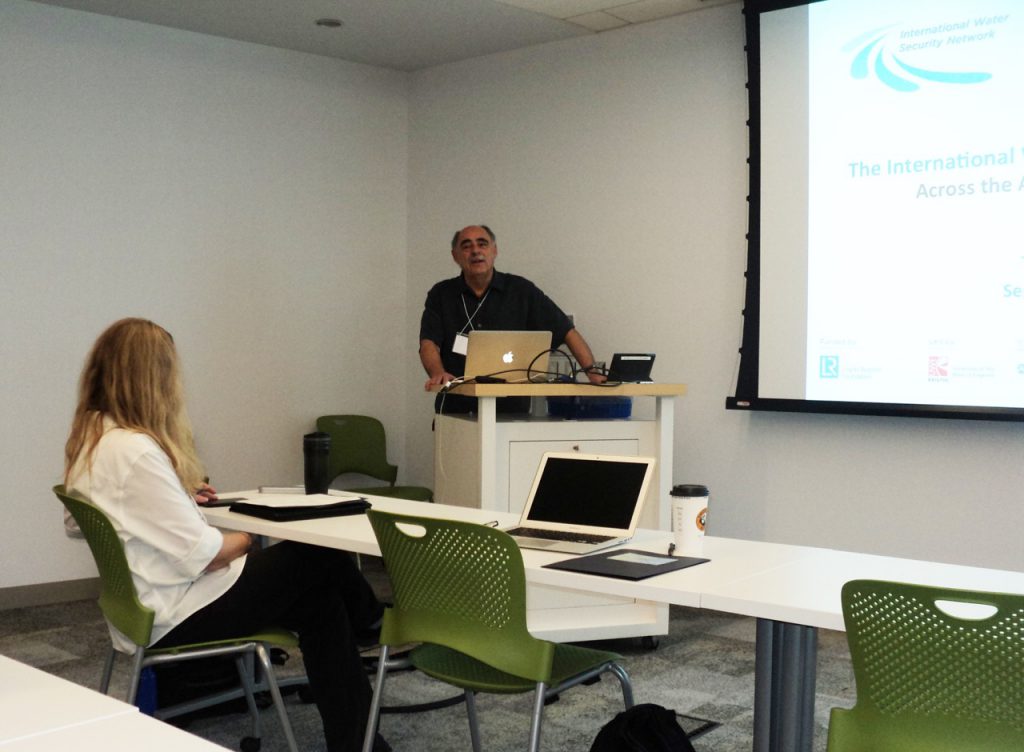
Annual Meeting in Tucson, AZ.
Initial Discussions
The leading researchers from each institution spent the first day of the meeting discussing project research objectives and experiences as well as the holistic approach from the IWSN team. UWE was represented by Dr. Chad Staddon and Dr. Enda Hayes. Among other things, Chad shared his work with his undergraduate students on bioenergy projects in East Africa, and Enda talked about his work on public engagement. Monash researchers Dr. Bimo Nkhata and Linda Downsborough shared how the IWSN has created momentum for their institution’s Master’s program, increasing considerably the number of enrolled students. UA researchers Dr. Robert Varady, Dr. Christopher Scott, and Dr. Adriana Zúñiga-Teran also shared their research experience working on transboundary water challenges across the Americas, emphasising how the IWSN network has grown significantly over the last two years, and currently includes partners in Mexico, Peru, Chile, and Argentina.
Student and Partners Presentations
On the meeting’s second day, IWSN partners from across the Americas working on transboundary water challenges in their own regions attended a series of presentations and shared their own research experiences.
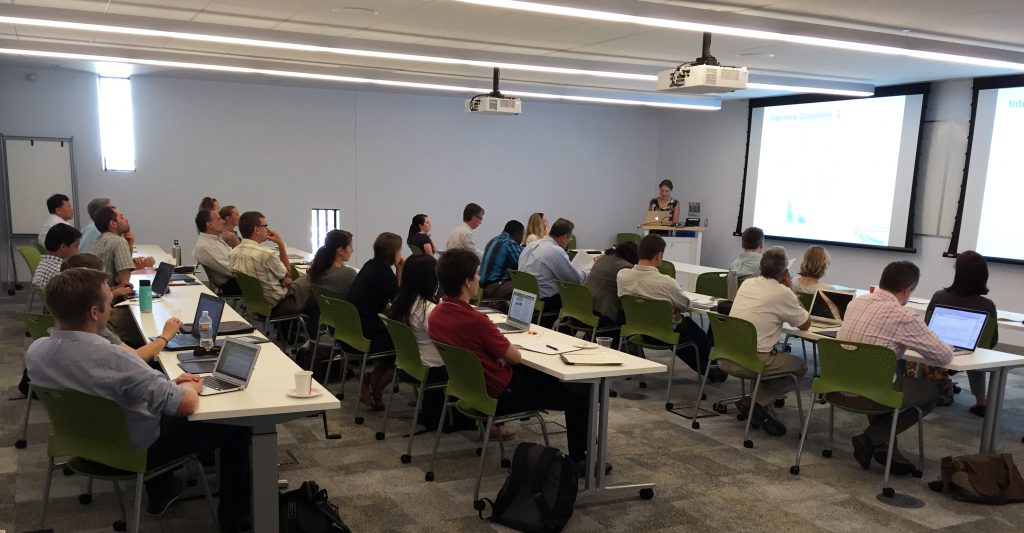
on the Colorado River, speaks to the IWSN partners.
Student awardees: The day began with talks from the two 2015 IWSN Undergraduate Project Award winners at the UA, Carly Herndon and Janine Clark, who presented their award winning work with middle school students and climate change, and their research on attitudes towards water and conservation in the southwest, respectively.
Chile-Argentina: Next, Dr. Facundo Martin from the Universidad Nacional de Cuyo and CONICET in Mendoza, Argentina, talked about his work on transboundary river basins shared by Chile and Argentina, with a focus on the Andean glaciers. Snow pack in this region provides water supply for both sides of the Andes. Facundo and his team will study and generate the hydroclimatological information needed to engage local stakeholders in science-policy dialogues.
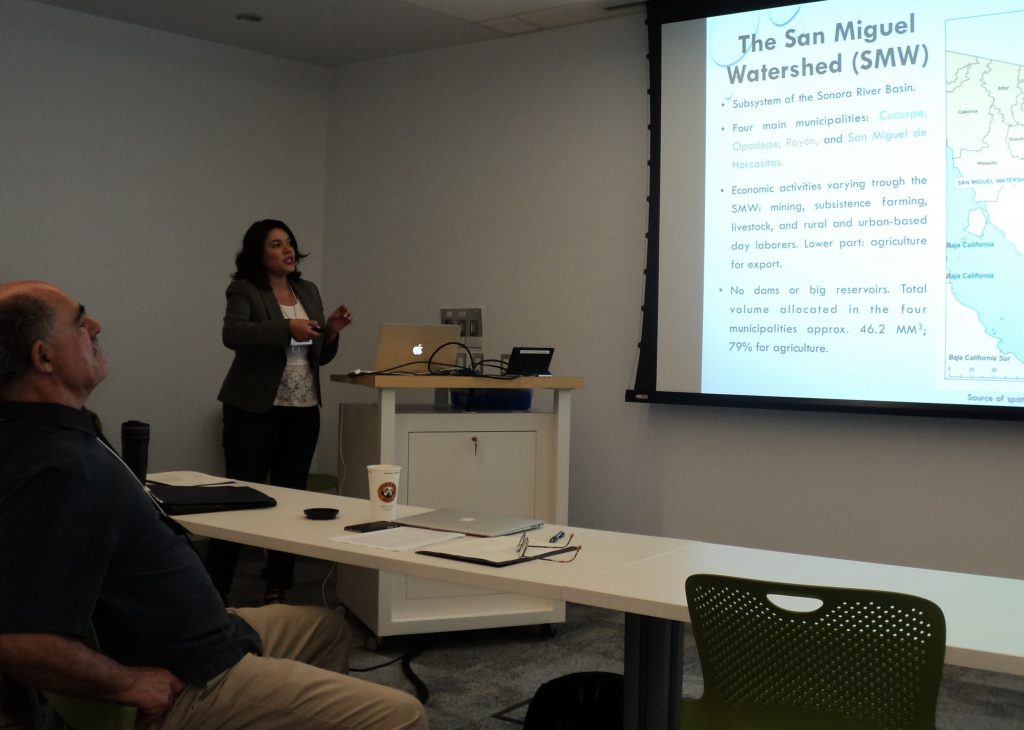
Sonora River Basin in Mexico.
Mexico: IWSN partner Dr. Nicolas Pineda from El Colegio de Sonora in Hermosillo, Mexico, shared his experience working with river basin councils, wastewater policy, and comparative wastewater implementation in different cities of Mexico, as well as his plans for future research on the feasibility of a desalination plant planned for the transboundary region of Sonora-Arizona. The group also heard a comparative analysis of water security challenges in the Río Sonora and the Río Yaqui basins in Sonora, Mexico, by two IWSN-supported graduate students: America Lutz-Ley, a UA Ph.D. student working in the Río Sonora basin, and Yulia Peralta, a UA Ph.D. student who is working in the Río Yaqui basin. America and Yulia are looking in their respective study areas at climate change adaptation initiatives and perceptions from local stakeholders.
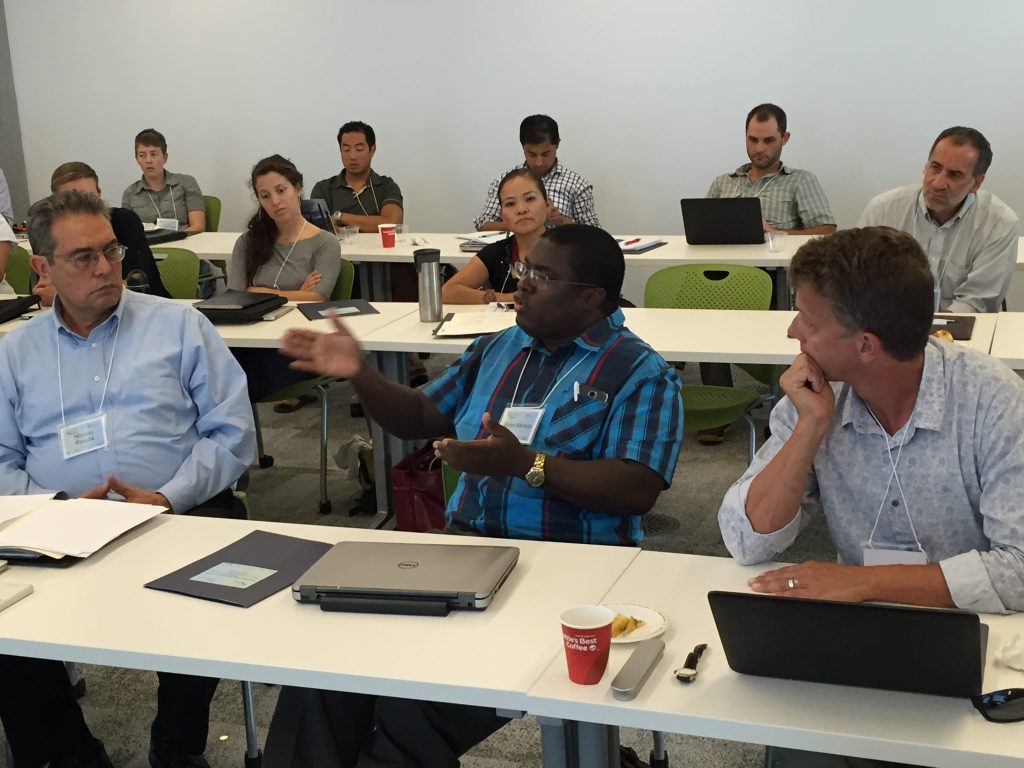
right: Dr. Nicolas Pineda, Dr. Bimo Nhkata and Dr. Chad Staddon.
Peru: IWSN partner Dr. Bram Willems from the Universidad Nacional Mayor de San Marcos in Lima, Peru, presented on his work in the Ica River Basin and the Piura River Basin, two basins in Peru that face very different water security challenges.
Nepal: UA Ph.D. student Bhuwan Thapa shared his research on water security impacts in local communities of Nepal as a consequence of the major earthquake event that happened last April 2015. Bhuwan has been awarded a three-year scholarship by the International Centre for Integrated Mountain Development (ICIMOD) and spent the summer of 2015 in Nepal collecting data and doing a qualitative assessment of community resilience.
China: Dr. Zifu Li from the University of Science and Technology in Beijing, China talked about his work on sanitation and wastewater management looking at biogas technology that generates electricity out of human waste. This work has the potential of having great impact in developing countries and refugee camps.
South Africa: From Asia the focus moved to South Africa, where Dr. Bimo Nkhata talked about how they are extending their network of scientists in the region. Bimo introduced the word “insaka” (that means “a place to come together and meet”), which is an African ‘community of practice’ centre. Insaka is a collaborative research program with other universities that allows cross learning on protected areas management.
Tucson: After lunch, the afternoon session focused on regional water management, and community engagement in the Tucson region. Several invited speakers shared their expertise, including Katie Bolger and Steve Arnquist, who represented Tucson City Council members and spoke about water conservation initiatives implemented in Tucson, which is considered a leader in water conservation efforts across the U.S. and beyond. Dr. Kelly Mott Lacroix from the Water Resource Research Center at the UA also spoke, focusing on her dissertation research on participatory engagement, and sharing her framework for community engagement and how to measure the effectiveness of these engagements.
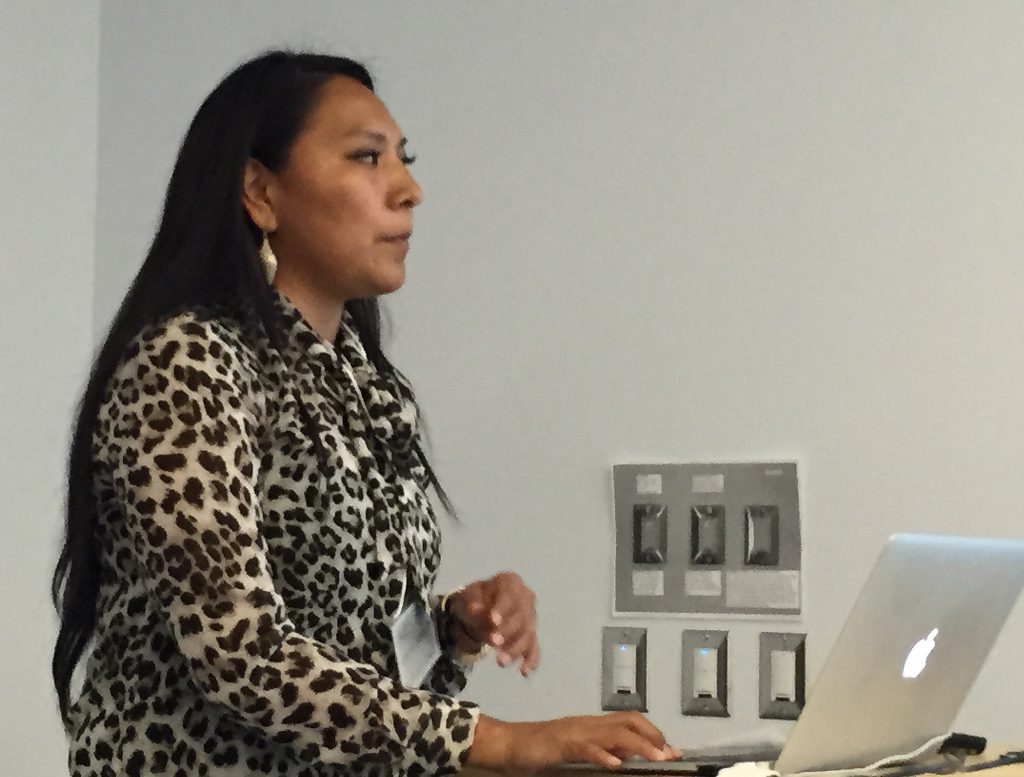
challenges faced by the Pyramid Lake Paiute Tribe.
Native nations: The group then heard from Dr. Karletta Chief, Assistant Professor at the Soil, Water and Environmental Sciences Department at the UA, and UA Ph.D. student Carrie Joseph, who shared their research on the Pyramid Lake Paiute Tribe, where the pollution upstream and the increasing withdrawals have resulted in dramatic declines in the lake levels, as well as on the water security interests of other southwest regional tribes.
Scenario planning: The session ended with Ralph Marra, a retired Tucson Water planner who now heads Southwest Water Resources Consulting, LCC. Ralph shared his experience in both in Tucson and in Mendoza, Argentina, with scenario planning, which allows a range of future possibilities (scenarios) to be integrated into decision-making.
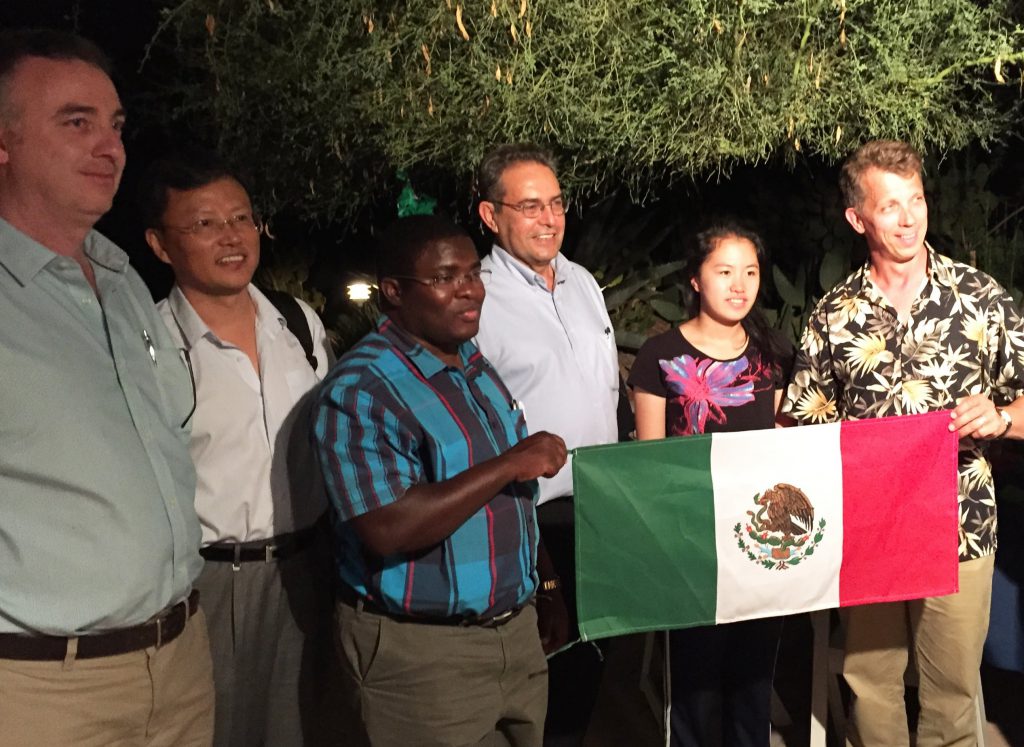
Mexican Independence Day. From left to right, Dr. Bram Willems,
Dr. Zifu Li, Dr. Bimo Nkhata, Dr. Nicolas Pineda, Dr. Li’s daughter,
and Dr. Chad Staddon.
Varady reception: An enriching session of questions and answered followed the talks and allowed attendees to strengthen their learning experience from this event. The second day of meetings closed with a warm reception hosted generously by Dr. Varady and his wife Evie at their beautiful home in the Catalina Foothills.
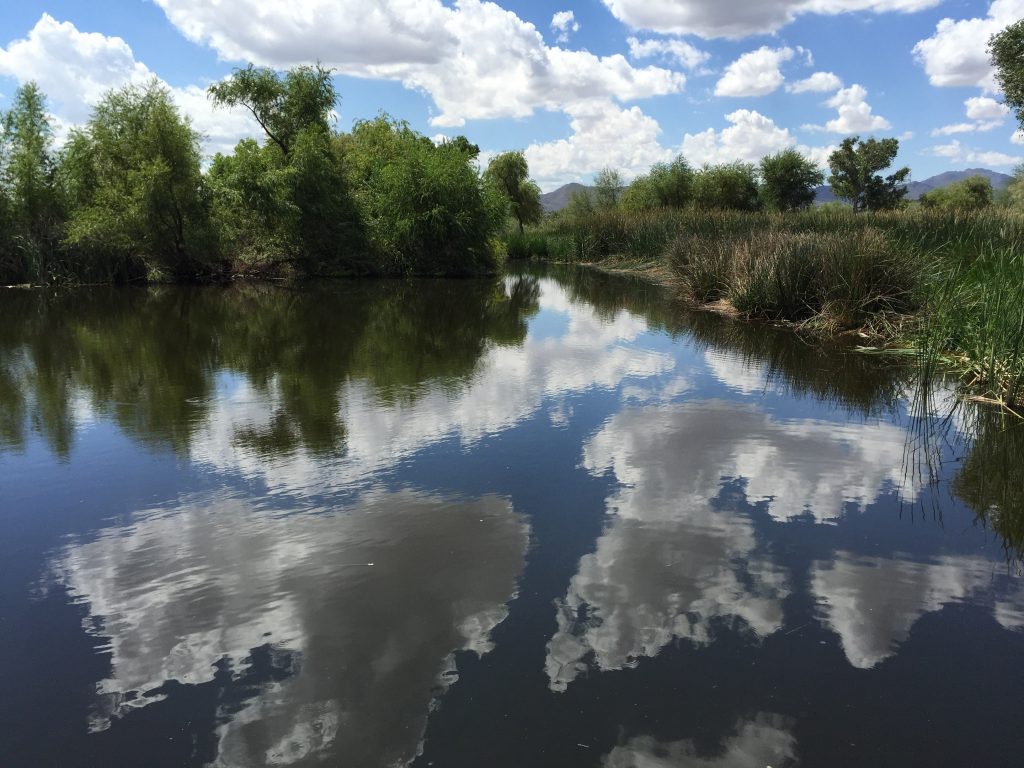
wastewater, creating a greenspace for the community and a sanctuary
for wildlife.
Field Trip and Tours
The third day of the meeting was spent on a fieldtrip that included several sites illustrating firsthand the water security topics addressed the day before. The group visited San Xavier del Bac, on the Tohono O’odham Nation located south of Tucson, where they admired the great mission built by the Jesuits hundreds of years ago and the alfalfa fields irrigated with water coming from the Colorado River as a result of the Tohono O’odham water rights settlement. The group also visited a pecan orchard in Green Valley as well as Duval Mine, two important water users of the region, and had lunch at the Sweetwater Wetlands Park, a wastewater treatment plant located in the middle of the city where nature thrives with reclaimed water. The fieldtrip ended with a visit to the Milagro Co-Housing Community, where residents highlighted their multiple water conservation techniques that include rainwater harvesting, rain gardens, wastewater treatment wetlands, saltwater shared pool, and pervious surfaces that allow water infiltration into the aquifers.
After a successful three-day event, the attendees said their goodbyes and made plans for the 2016 IWSN meeting in South Africa.
